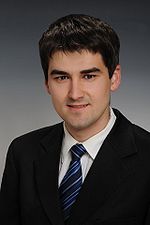Difference between revisions of "Horvath 2012 Abstract Bioblast"
| Line 6: | Line 6: | ||
|event=[[Bioblast 2012]] | |event=[[Bioblast 2012]] | ||
|abstract=[[File:Gergö.jpg|right|150px|Gergö Horvath]] | |abstract=[[File:Gergö.jpg|right|150px|Gergö Horvath]] | ||
Mitochondria play a key role in the pathogenesis of different diseases including the pathologies of the heart. According to the World Health Organization, chronic diseases are responsible for 63% of all deaths in the world, with cardiovascular disease as the leading cause of death. | Mitochondria play a key role in the pathogenesis of different diseases including the pathologies of the heart. According to the World Health Organization, chronic diseases are responsible for 63% of all deaths in the world, with cardiovascular disease as the leading cause of death. New findings of the cardiac muscle mitochondria functions can be further used to develop new therapeutic strategies. | ||
The most important parameters of heart mitochondrial activity are oxidative phosphorylation capacity and mitochondrial membrane potential. With these two properties of mitochondria we can determine the coupling state of respiration and the impact of the mitochondrial substrate on the membrane potential [1]. The | The most important parameters of heart mitochondrial activity are oxidative phosphorylation capacity and mitochondrial membrane potential. With these two properties of mitochondria we can determine the coupling state of respiration and the impact of the mitochondrial substrate on the membrane potential [1]. The Fluorescence module for the Oxygraph-2k (Oroboros Instruments, Innsbruck) combines optical measurement with [[high-resolution respirometry]] and with this new technology it is possible to detect changes in both parameters simultaneously. | ||
The experiments were carried out in mouse heart homogenate. The measurements were performed using the | The experiments were carried out in mouse heart homogenate. The measurements were performed using the O2k. We detect the oxygen-consumption with a Clark-electrode and the membrane potential changes with safranin fluorescence dye at 480 nm. | ||
The experiments were carried out following SUIT protocols, with minor modifications [2]. We investigated Complex I and II and a combination of I+II in different coupling control levels. | The experiments were carried out following SUIT protocols, with minor modifications [2]. We investigated Complex I and II and a combination of I+II in different coupling control levels. | ||
Revision as of 11:46, 30 November 2012
| Horvath G, Eigentler A, Gnaiger E, Tretter L (2012) Respiratory substrate effects on mitochondrial membrane potential - experiments with mouse cardiac muscle homogenate. Mitochondr Physiol Network 17.12. |
Link: MiPNet17.12 Bioblast 2012 - Open Access
Horvath G, Eigentler A, Gnaiger E, Tretter L (2012)
Event: Bioblast 2012
Mitochondria play a key role in the pathogenesis of different diseases including the pathologies of the heart. According to the World Health Organization, chronic diseases are responsible for 63% of all deaths in the world, with cardiovascular disease as the leading cause of death. New findings of the cardiac muscle mitochondria functions can be further used to develop new therapeutic strategies.
The most important parameters of heart mitochondrial activity are oxidative phosphorylation capacity and mitochondrial membrane potential. With these two properties of mitochondria we can determine the coupling state of respiration and the impact of the mitochondrial substrate on the membrane potential [1]. The Fluorescence module for the Oxygraph-2k (Oroboros Instruments, Innsbruck) combines optical measurement with high-resolution respirometry and with this new technology it is possible to detect changes in both parameters simultaneously.
The experiments were carried out in mouse heart homogenate. The measurements were performed using the O2k. We detect the oxygen-consumption with a Clark-electrode and the membrane potential changes with safranin fluorescence dye at 480 nm. The experiments were carried out following SUIT protocols, with minor modifications [2]. We investigated Complex I and II and a combination of I+II in different coupling control levels.
- Brand MD, Nicholls DG (2011) Assessing mitochondrial dysfunction in cells (2011) 435: 297–312. Open Access
- Pesta D, Gnaiger E (2012) High-resolution respirometry. OXPHOS protocols for human cells and permeabilized fibres from small biopisies of human muscle. Methods Mol Biol 810: 25-58.
• Keywords: Mitochondrial membrane potential, Cardiac muscle
• O2k-Network Lab: HU Budapest Tretter L, AT Innsbruck OROBOROS
Labels:
Organism: Mouse
Tissue;cell: Cardiac muscle"Cardiac muscle" is not in the list (Heart, Skeletal muscle, Nervous system, Liver, Kidney, Lung;gill, Islet cell;pancreas;thymus, Endothelial;epithelial;mesothelial cell, Blood cells, Fat, ...) of allowed values for the "Tissue and cell" property.
Preparation: Homogenate
Coupling state: LEAK, OXPHOS, ETS"ETS" is not in the list (LEAK, ROUTINE, OXPHOS, ET) of allowed values for the "Coupling states" property.
HRR: Oxygraph-2k, Spectrofluorimetry"Spectrofluorimetry" is not in the list (Oxygraph-2k, TIP2k, O2k-Fluorometer, pH, NO, TPP, Ca, O2k-Spectrophotometer, O2k-Manual, O2k-Protocol, ...) of allowed values for the "Instrument and method" property.
Affiliations and author contributions
Horvath Gergoe (1), Eigentler Andrea (2), Gnaiger Erich (2,3), Tretter Laszlo (1)
(1) Department of Medical Biochemistry, Semmelweis University, Budapest, Hungary; Email: [email protected]
(2) Medical University of Innsbruck, Department of Visceral, Transplant and Thoracic Surgery, D. Swarovski Research Laboratory, Innsbruck, Austria
(3) Oroboros Instruments Corp, High Resolution Respirometry, Innsbruck, Austria
